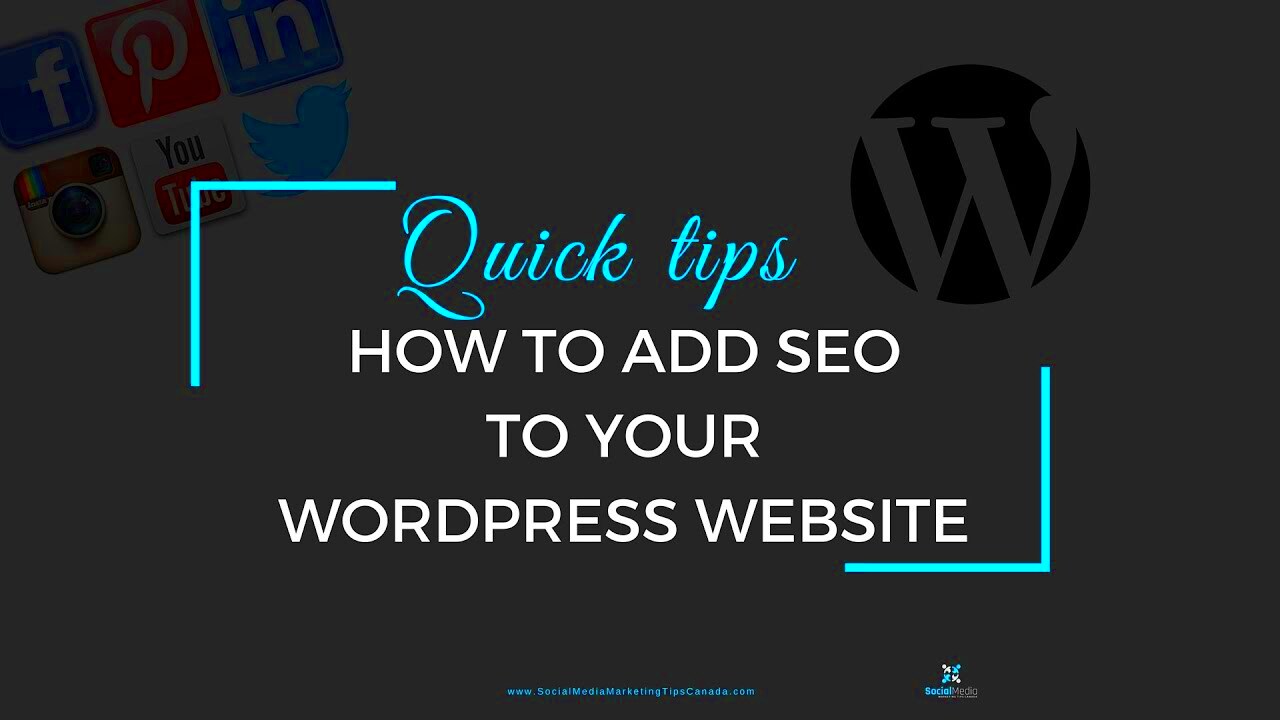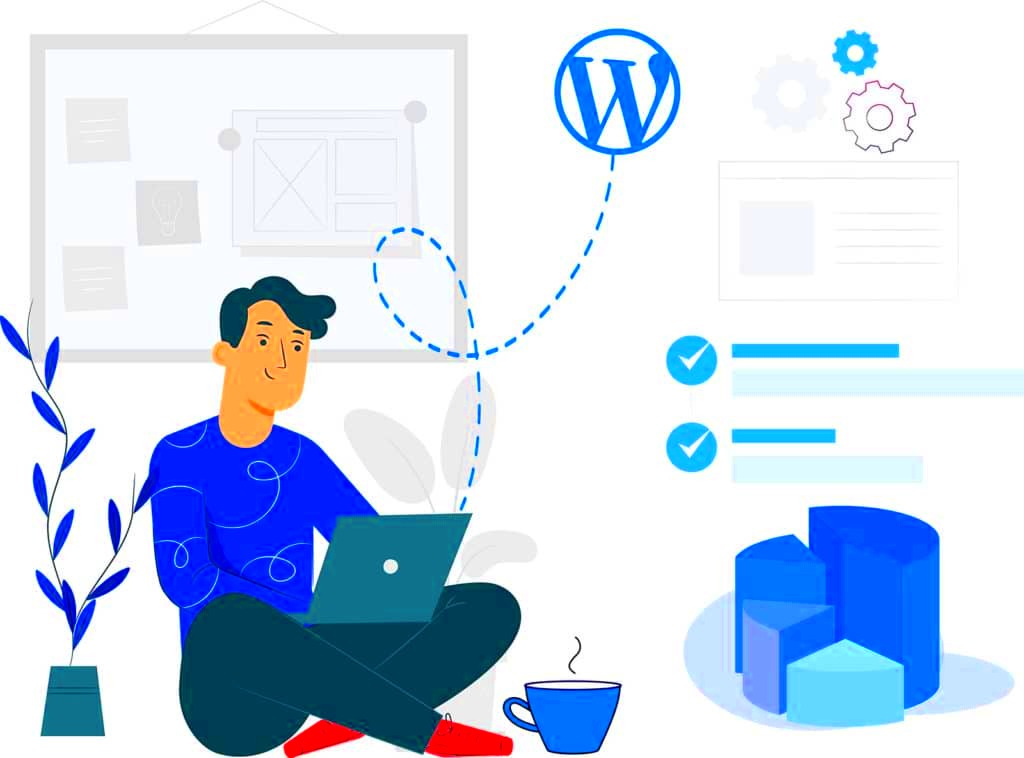Search Engine Optimization (SEO) is a set of strategies to improve your website’s visibility in search engine results. If you’re using WordPress, the good news is that implementing SEO is relatively straightforward. WordPress provides a robust foundation for SEO, making it easier for search engines to crawl and index your site. In this section, we’ll explore what SEO is, how it impacts your online presence, and why
Why SEO is Important for Your WordPress Site

Understanding the significance of SEO is crucial for anyone looking to succeed online. Here are several reasons why SEO is essential for your WordPress site:
- Increased Visibility: SEO helps your site rank higher on search engine results pages (SERPs). The higher you rank, the more likely people will click through to your site.
- More Organic Traffic: With better rankings comes increased organic traffic. This means more visitors without paying for ads.
- Building Credibility: Sites that rank well are often perceived as more credible and trustworthy. A well-optimized site can enhance your reputation.
- Improved User Experience: SEO best practices lead to a better user experience, which can reduce bounce rates and encourage users to spend more time on your site.
- Competitive Advantage: If your competitors are optimizing for SEO, you can’t afford to ignore it. A well-optimized site gives you a better chance against competitors.
In summary, SEO is not just an option; it’s a necessity for any WordPress site aiming for success. Whether you’re a blogger, a business owner, or anything in between, understanding and implementing SEO can help you reach your goals effectively.
Choosing the Right SEO Plugin

When it comes to optimizing your WordPress website for search engines, the right SEO plugin can make all the difference. With a wide array of options available, finding the one that suits your needs can feel overwhelming. But fear not! This guide will help you navigate through the top picks and factors to consider.
Popular SEO plugins like Yoast SEO, All in One SEO Pack, and Rank Math each bring different features to the table. So, let’s break it down:
- Yoast SEO: Widely known for its user-friendly interface, Yoast offers a plethora of features including content analysis, snippet previews, and XML sitemaps. It’s perfect for beginners and seasoned pros alike.
- All in One SEO Pack: As the name suggests, this plugin provides an all-encompassing toolset for your SEO needs. Its features include title customization, automatic meta tag generation, and support for eCommerce sites.
- Rank Math: A newcomer on the block that has rapidly gained popularity. It combines a simple interface with powerful features like rich snippet support and keyword tracking, making it a great choice for those who like flexibility.
When choosing your plugin, consider the following:
- User-Friendliness: Make sure you can navigate the plugin without any hassle.
- Support and Updates: Check if the plugin is regularly updated and supported by its developers.
- Features: Identify your needs and ensure the plugin includes features essential for your strategy.
Ultimately, selecting the right SEO plugin is about what works best for you and your website’s goals. Take your time, explore different options, and remember to check user reviews for an insightful perspective.
Setting Up Permalinks

Permalinks are the permanent web addresses (URLs) for your content, and setting them up correctly is crucial for both SEO and user experience. A well-structured permalink can significantly enhance your site’s visibility in search engines and make it easier for visitors to navigate your content.
WordPress offers several permalink structures, but the most effective is typically the “Post name” option. Here’s how to set it up:
- Go to your WordPress dashboard.
- Navigate to Settings > Permalinks.
- Select Post name from the options.
- Click on Save Changes.
This simple change gives your URLs a cleaner look, making them more understandable and clickable. For instance, a URL like www.yoursite.com/this-is-your-post is far more appealing and informative than www.yoursite.com/?p=123.
Additionally, consider incorporating keywords into your permalinks. This can be a small but effective way to improve your SEO. For example, if your post is about gardening tips, a URL like www.yoursite.com/gardening-tips can signal to search engines that your content is relevant.
Always remember to avoid using special characters or stop words in your permalinks, as these can complicate the URL and hinder SEO efforts. In summary, setting up clean, keyword-friendly permalinks is a vital step in enhancing your WordPress website’s SEO.
5. Optimizing Your Content

Content is the backbone of your website, and optimizing it for search engines is crucial for boosting your visibility. Think of it this way: if your content isn’t doing its job, then no one will ever see it! So, how can you optimize your content effectively? Let’s break it down.
First, you want to focus on relevant keywords. Start by conducting keyword research to find out what terms your target audience is using. Tools like Google Keyword Planner, Ahrefs, or SEMrush can help. Once you have your keywords, integrate them naturally into your content. Here’s how:
- Title: Use your primary keyword in the title.
- Headings: Include keywords in H2 and H3 headings to improve structure and relevance.
- Content: Sprinkle your keywords throughout the text, but avoid stuffing them in; it should read naturally.
- Meta Description: Write a compelling meta description containing your target keyword to improve click-through rates.
Next, don’t underestimate the power of images! Optimize your images by using descriptive file names and adding alt text that incorporates your keywords. This not only helps with SEO but also improves accessibility for visually impaired users.
Last but not least, make sure your content is engaging. Use short paragraphs, bullet points, and images to break up the text. Internal linking to other relevant articles on your site can also help keep visitors engaged and improves site structure.
6. Configuring Your SEO Plugin Settings
Once you have your content optimized, it’s time to set up your SEO plugin settings. If you’re using popular plugins like Yoast SEO, All in One SEO Pack, or Rank Math, you have a powerful toolbox at your fingertips. Let’s talk about how to configure these settings to maximize your SEO efforts.
1. Basic Configuration: First, navigate to the settings of your chosen SEO plugin. Here, you’ll find options to input your website’s title and meta description. This is where you should align your site’s vision with relevant keywords.
2. XML Sitemap: Most SEO plugins will create an XML sitemap for you automatically. This helps search engines understand the structure of your website and index it more effectively. Make sure this option is enabled!
3. Social Media Integration: Don’t forget about social media! Check the settings that allow you to input social media information for better sharing options. This includes Open Graph settings for Facebook and Twitter Cards.
4. Content Optimization Features: Some plugins offer real-time content analysis while you write. Enable these features to receive instant feedback on your on-page SEO, including keyword density, readability, and more!
5. Advanced Settings: If you’re comfortable diving deeper, explore settings like schema markup, breadcrumbs, and redirect management. These options can significantly enhance SEO performance but require a bit more technical understanding.
After configuring these settings, don’t forget to regularly check back and adjust them as needed based on your website’s performance and any changes in SEO best practices. Happy optimizing!
Using Categories and Tags Effectively
When it comes to organizing your WordPress content, utilizing categories and tags effectively can make a significant difference in your website’s SEO performance. Think of categories as overarching topics that encompass several posts, while tags are used to dig deeper into specific details and themes within those posts. This structured approach not only helps search engines understand your content better but also enhances the user experience.
Here’s how you can make the most out of categories and tags:
- Keep Categories Broad: Aim for 5-10 main categories that cover the general themes of your content. This gives visitors a clear understanding of your site’s focus areas.
- Use Tags for Specificity: Tags are more specific and can relate to particular topics within a post. Use them to highlight distinct themes, keywords, or important points.
- Avoid Overusing Tags: Too many tags can dilute the effectiveness of your labeling system. Stick to around 10-15 tags for each post that truly represent the content.
- SEO-Friendly Names: When naming your categories and tags, think like a user. Incorporate relevant keywords that reflect your content, but don’t overstuff. Keep it natural.
- Interlinking: Create interlinks between posts with similar categories or tags. This not only helps search engines crawl your site more effectively but also keeps users engaged.
By implementing these strategies, you can create a clear structure that enhances your site’s SEO while making it easier for readers to navigate. Remember, an organized site fosters trust and encourages more visitors to return!
Image Optimization for Better SEO
Images are a valuable asset for your WordPress site, but if they’re not optimized properly, they can significantly slow down your page loading speed, which can hurt your SEO. Optimizing images is about refining their size, format, and the accompanying metadata, ensuring your website remains fast and user-friendly.
To optimize your images for better SEO, consider the following tips:
- Choose the Right File Format: Use JPEG for photographs, PNG for images that require transparency, and GIF for simple animations. Each format serves a purpose and can affect loading times.
- Compress Images: Before uploading images to your site, use tools like TinyPNG or ImageOptim to reduce the file size without losing quality. This can significantly speed up your site.
- Use Descriptive Filenames: Instead of generic names like “image1.jpg,” use descriptive filenames that include keywords, such as “blue-running-shoes.jpg.” This helps search engines understand what the image is about.
- Alt Text Matters: Always fill in the alt text for your images. This text helps describe the image to search engines and is essential for accessibility. Aim for relevant and descriptive alt tags.
- Implement Image Sitemaps: Consider creating an image sitemap or ensuring your general sitemap includes image URLs. This helps search engines index your images effectively.
By taking these steps to optimize your images, you not only enhance your site’s speed but also improve its overall SEO performance. You’ll likely notice an increase in organic traffic while providing a better experience for your visitors.
Improving Site Speed
Speed is everything when it comes to user satisfaction and search engine rankings. If your website takes too long to load, visitors will bounce, and search engines like Google might penalize you. So, how do you make your WordPress site speedier? Let’s break it down!
- Optimize Images: Large images can slow down your site significantly. Use plugins like Smush or EWWW Image Optimizer to compress images without losing quality.
- Use a Caching Plugin: A caching plugin like WP Super Cache or W3 Total Cache stores a static version of your site, which loads quicker for returning visitors.
- Minimize HTTP Requests: Reduce the number of elements on your page to limit HTTP requests. Combine CSS and JavaScript files where possible.
- Choose a Fast Hosting Provider: Not all hosting companies are created equal. Look for ones that specialize in WordPress hosting with fast servers.
- Use a Content Delivery Network (CDN): A CDN stores copies of your site in multiple locations worldwide, ensuring faster load times for visitors, regardless of their location.
- Disable Unused Plugins: Deactivate any plugins you’re not actively using. Each plugin can add extra load time, so fewer is often better.
By following these strategies, you’ll not only improve your site speed, but also enhance user experience and boost your SEO simultaneously!
Implementing Schema Markup
Schema markup may sound complex, but it’s essentially a way to provide search engines with specific data about your website. It’s like giving Google a cheat sheet for understanding your content better. So, what does that mean for your WordPress site?
Simply put, implementing schema markup can enhance your search engine listings. You could get rich snippets—those eye-catching reviews, ratings, and other details that make your listing stand out. Here’s how to get started:
- Use a Schema Plugin: Plugins like Schema Pro or WP SEO Structured Data Schema make it easy to add schema markup without coding. Just fill in the necessary details, and you’re good to go!
- Identify Your Content Type: Determine what type of schema markup you need—be it articles, products, events, or local business information.
- Fill Out Required Fields: Each schema type has required fields. Make sure to fill these out accurately to ensure your markup is valid.
- Test Your Markup: Use Google’s Structured Data Testing Tool to check your markup and make sure there are no errors.
- Monitor Impact: After implementing schema markup, monitor your site’s performance in the search results. You should start seeing an increase in clicks and impressions!
Implementing schema markup is a small step, but it can lead to big improvements in your visibility on search engines. So don’t skip it!
11. Monitoring and Analyzing Your SEO Performance
Now that you’ve set up your SEO strategies on your WordPress website, the work isn’t over. In fact, one of the most crucial parts comes next: monitoring and analyzing your performance. Why is this important? Well, SEO isn’t a one-time activity; it’s an ongoing process. By keeping tabs on your performance, you can identify what’s working, what’s not, and where you need to adjust your approach.
First off, make use of tools like Google Analytics and Google Search Console. These allow you to track important metrics, such as:
- Organic Traffic: How many visitors are coming to your site from search engines?
- Bounce Rate: Are visitors leaving your site quickly, or are they exploring more pages?
- Keyword Rankings: Which keywords are driving traffic to your site, and how do their rankings change over time?
- Conversion Rate: Are visitors taking desirable actions like signing up or making a purchase?
Additionally, it’s essential to keep track of your backlinks. Consider using tools like Ahrefs or SEMrush to analyze your backlink profile. Strong backlinks can significantly boost your website’s authority, while toxic backlinks can harm it.
Lastly, don’t forget about user feedback and engagement metrics. Keep an eye on comments, social shares, and overall audience interaction. By analyzing this data regularly, you can fine-tune your strategies and ensure you’re on a path to long-lasting SEO success.
12. Conclusion and Next Steps
Congratulations! You’ve made it through the essential steps to set up SEO on your WordPress website. By now, you should have a solid understanding of how to optimize your site for search engines, create valuable content, and, most importantly, monitor your SEO performance.
So what’s next? Here’s a handy checklist to keep you on track:
- Regularly Review Analytics: Set aside time each month to analyze your Google Analytics and Search Console data.
- Update Content: Refresh old posts with new information and optimize them for keywords you’ve discovered.
- Test New Strategies: Don’t be afraid to experiment with different keywords or content formats to see what resonates with your audience.
- Stay Informed: The SEO landscape is always changing. Follow industry blogs, attend webinars, or join relevant social media groups to keep up with the latest trends.
Remember, SEO is not just about ranking higher on search engines; it’s about providing value to your audience and creating a more accessible web experience. With a little dedication and consistently analyzing your performance, your website can achieve its full potential! So, gear up for the journey ahead and start implementing these next steps. Happy optimizing!



